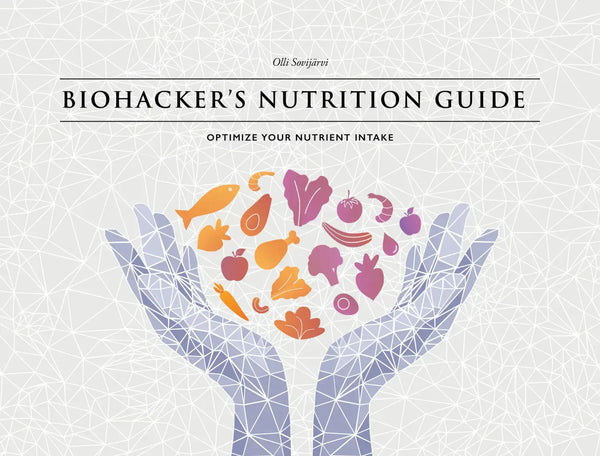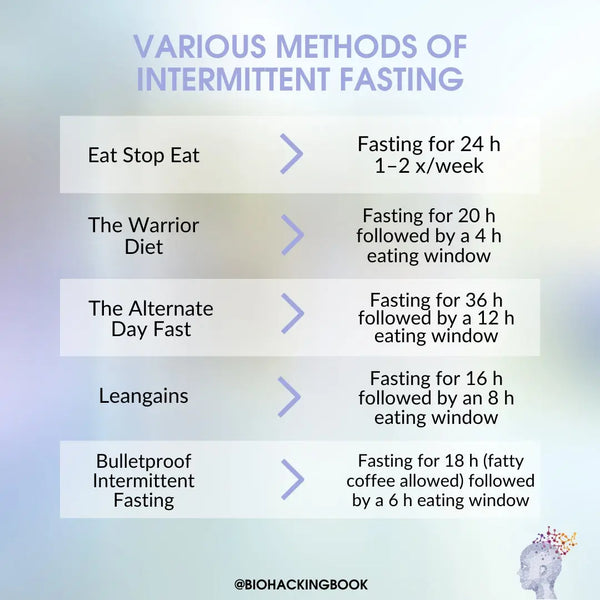Testosterone is a hormone that plays a vital role in male physical and mental health. It's essential for strength, muscle mass, energy, libido and overall well-being. Unfortunately, testosterone levels naturally decline with age. Luckily, there are natural ways to optimize testosterone production, which are all covered in this comprehensive article.
Medical & Healthcare Disclaimer
The information in this article is not intended or implicitly suggested as an alternative for professional diagnoses or professionally recommended treatments & medical advice. This article is based on the personal experiences of its author, and the advice it contains is based on a combination of experience and scientific research. All of the content, including the article text itself, images, comments, and other information, on this web page is for non-specific information purposes only. We suggest always paying attention to professional health and medical advice provided by your doctor or other healthcare professionals. The products recommended in this article are not for diagnosing, preventing, monitoring, treating, or alleviating any specific disease, injury, or disability.
Introduction – Why Most Testosterone Advice Don't Work
I originally wrote this article in 2016. It was a request from Ben Greenfield based on our conversation on boosting testosterone levels naturally. The article was first published on his site and got really popular back then.
You can find many articles, videos, and e-books on optimizing testosterone on the web, and even a bunch of (great) e-books have been released. I have read and studied all of them and beyond. Many promising supplements, pills, and tricks sound good but must be revised. In reality, a large portion of testosterone-boosting supplements does not work.
Still, with the tricks presented later in the article, I have had to dig deep from the depths of Pubmed and spent hundreds of hours reading every possible study that could find something new on one of the most critical hormones for men.
Before we jump into these natural methods for optimizing your testosterone, I want to make clear that you have the basics covered. With adequate training, nutrition, sleep, and stress management, these tricks will be as solid as they can be. You can read more about optimizing sleep, nutrition, stress, and exercise from Biohacker's Handbook.
The Testosterone Basics
Testosterone is an anabolic sex steroid hormone, which is mainly released in Leydig cells of the testes (95%). Testosterone is not just a male hormone; women also produce it in the ovaries but of less magnitude. Men have roughly ten times more testosterone than women. Testosterone is derived from cholesterol,"the mother of all steroids."
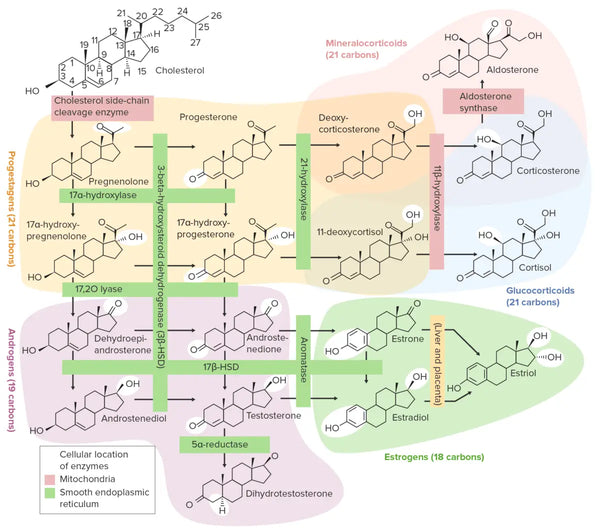
Image: Overview of the steroidogenesis pathways.
Source: Lecturio.com.
Testosterone is responsible for men's sexual characteristics: it stimulates the growth of the penis and scrotum, increases the growth of body and facial hair (which is otherwise highly genetically regulated; so little body hair doesn't automatically mean low testosterone), impacts an ability to put on muscle mass and lose fat and even affects the tone of the voice by strengthening vocal cords.
Testosterone is also an anti-aging hormone, which means that a healthy level of testosterone throughout your life can make you live longer. In men aged 30 years and older, testosterone levels steadily fall at a rate of about 1% per year.
Physiology of Testosterone
A feedback loop from the brain to the testes controls how much testosterone is released. The hypothalamus secretes gonadotropin-releasing hormone (GnRH), which stimulates the pituitary gland to secrete two essential hormones: luteinizing hormone (LH, see below) and follicle-stimulating hormone (FSH). In men, LH stimulates the secretion of testosterone in the testicles. In women, LH mainly stimulates the secretion of estrogen and progesterone. The testosterone produced is released into the blood. Most of this (98 %) is biologically inactive (SHBG-bound) testosterone. The rest is biologically active (free) testosterone. SHBG releases testosterone as needed. Depending on the tissues, testosterone can be further converted to dihydrotestosterone or estradiol.
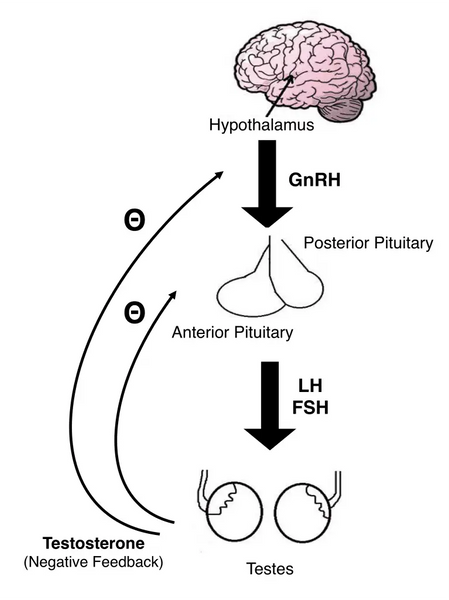
Image: The HPG-axis.
Produced testosterone enters the bloodstream as free testosterone, which is biologically available. The majority (c.a. 98%) of the produced testosterone is then bound to sex hormone binding globulin (SHBG) or albumin (another major protein in the blood). For testosterone to become" active," you want to release it from the carrier protein and optimal SHGB levels in the blood.
For testosterone to have an anabolic effect in the body, it must bind to an androgen receptor, for example, in the muscle tissue. Strength training activates these receptors and their expression; bioavailable testosterone can bind to free androgen receptor sites. After that begins a cascade in the cell, which eventually enters DNA and starts protein synthesis. Therefore it is crucial to have a good androgen sensitivity and density (see later in this article how to improve these).
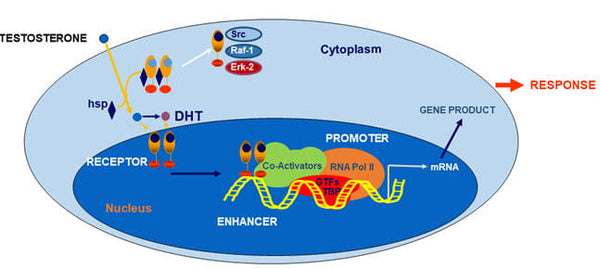
Image: Simplified model of androgen action in an androgen target cell.
Source: McEwan, I. & Brinkmann, A. (2021). Androgen physiology: receptor and metabolic disorders. Endotext [Internet].
Testosterone binds to androgen receptors (ARs) through a process known as hormone-receptor binding. The testosterone molecule binds to the androgen receptor's hydrophobic pocket, made up of amino acids. This pocket is located in the DNA-binding domain of the androgen receptor. Once the testosterone molecule binds to the androgen receptor, it triggers the androgen receptor to move to the cell's nucleus and activate the genes for specific proteins. This process is known as gene transcription, and it is how testosterone exerts its effects on cells. The proteins produced from this gene transcription are responsible for the androgenic effects of testosterone, such as muscle growth and male sexual characteristics.
Testosterone is also a hormone that plays a crucial role in carbohydrate, fat, and protein metabolism. That is why it significantly influences body fat composition and muscle mass, especially in males. Research has over and over again shown that testosterone deficiency is related to various metabolic health problems: increased fat mass (central adiposity), reduced insulin sensitivity, and glucose tolerance, possibly leading to metabolic syndrome, type 2 diabetes, and even cardiovascular disease (CVD). Testosterone deficiency has been reported in population studies to be associated with an increase in all-cause mortality (mainly linked to CVD). Healthy levels of testosterone also protect from cognitive decline.
Essential lifestyle hacks for higher testosterone
1. Improve the quality and quantity of your sleep
The majority of the daily testosterone release in men occurs during sleep. Fragmented sleep and obstructive sleep apnea are associated with reduced testosterone levels. A study released in The Journal of the American Medical Association found out that one week of sleep restriction (5 hours of sleep per night) decreased testosterone production by 10–15%. Studies have also found that sleep’s effect on testosterone has an inverted U-shaped curve. Testosterone production increased with increasing sleep duration up to 10 hours, after which it decreased.
Read a massive article on how to improve your deep sleep by Dr. Olli Sovijärvi.
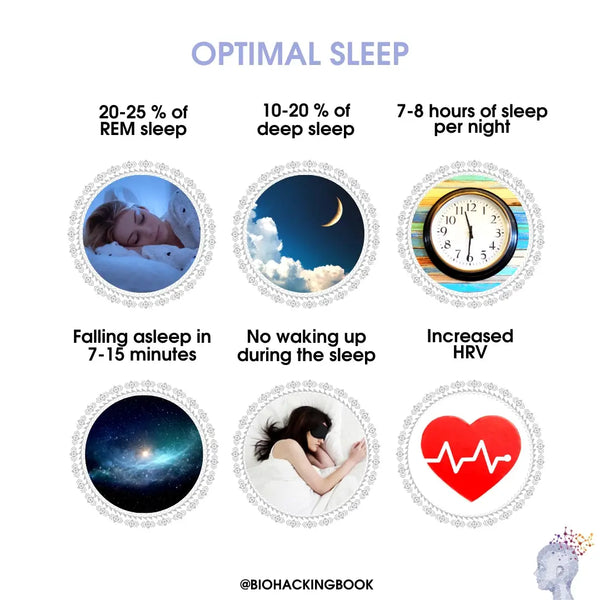
2. Get rid of extra belly fat and be lean
Research generally shows that the higher your body fat percentage, the lower the testosterone. The correlation works especially in the direction that getting leaner will raise your testosterone levels.
”Longitudinal analyses showing no influence of baseline hormone levels on change in anthropometric measures imply that body composition affects hormone levels and not the reverse.”
It has been roughly estimated that a male body fat percentage between 8–15% is optimal regarding testosterone production. Higher fat mass also usually increases aromatase enzyme activity, which converts more testosterone into estrogen.In opposition, too low body fat content can be detrimental to testosterone production.
3. Practice strength training and gain some muscle mass
While practicing strength training and gaining muscle often reduces body fat percentage (which leads to higher testosterone), it also has an independent effect on elevating testosterone. Having higher muscle mass is positively correlated with higher testosterone. Lifting medium-heavy weights explosively can stimulate short-term and long-term testosterone production. Training progressively will force your body to adapt to higher and higher testosterone levels via neuromuscular adaptations.
Follow these principles when strength training for optimal testosterone production:
- Lift explosively (with perfect form)
- Lift heavy enough, but not too heavy (to have an optimum force/velocity curve)
- Use compound lifts to activate large amounts of muscle mass
- Focus on body parts that have a high density of androgen receptor sites (chest, shoulders, trapezius)
- Do sprint intervals to maximize force production in minimal time and to activate fast-twitch muscle fibers
- Do as much work on as much muscle tissue as possible in an as short amount of time as possible while staying under the negative stress threshold
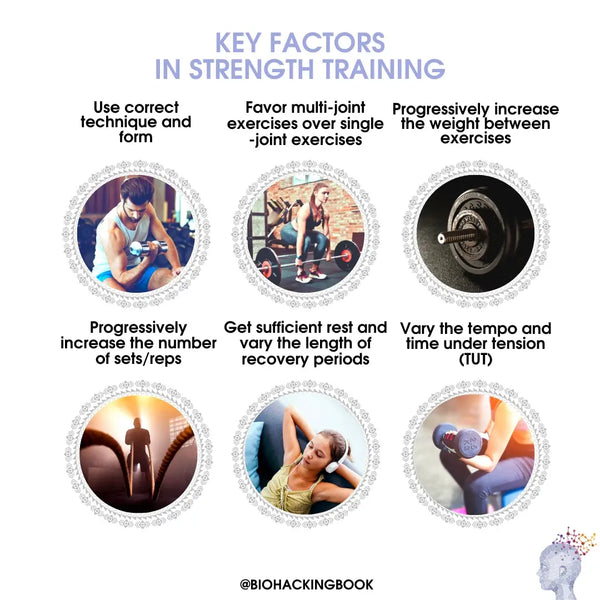
4. Control your stress levels and meditate
Chronic stress eventually leads to chronically elevated cortisol levels in the blood. Cortisol is necessary for life, but excreted too much for too long can cause serious health problems. One of the disadvantages is diminished testosterone secretion, as cortisol and testosterone compete with the same hormonal precursors and raw materials (mainly pregnenolone). For example, in military conditions, prolonged stress has been shown to significantly lower testosterone secretion.
Implement these well-researched strategies into your life to lower stress:
- Meditation (in particular) and relaxation exercises such as deep breathing
- Spending cell phone free time in nature and walking
- Eating enough whole-food carbohydrates (especially in the evening and when having an intense period of exercise)
- Adaptogenic herbs (ashwagandha in particular)
- Vitamin C (the more stress, the more vitamin C you need)
- Phosphatidylserine (600mg per day)
5. Eat nutrient-dense whole foods and get enough (but not too many) calories
Micronutrients
Getting enough and an optimal amount of micronutrients is crucial for testosterone production. Measuring your micronutrient status is an essential step in finding out what your exact situation is. The most important micronutrients for testosterone production are zinc, magnesium, calcium, vitamin D, B vitamins, iodine, selenium, vitamin K2, vitamin A, vitamin E, manganese and boron.
Eating a diet rich in nutrients and minerals (read: whole foods) is crucial not just for overall health, but also for optimal testosterone production. Getting a multivitamin supplement based on your personal needs can also be testosterone-saving if your diet lacks something. The best way to determine your needs is to take a complete blood panel on all the essential micronutrients.
CAN ZINC BOOST TESTOSTERONE LEVELS?
The common belief is that zinc can boost testosterone production in men. Higher zinc levels have indeed been linked to higher testosterone levels in healthy men. Taking oral zinc supplements may slightly increase testosterone levels in men with relatively low baseline testosterone levels (less than 4.8 ng/dL or 200 pmol/l). However, zinc does not significantly impact testosterone production in physically active men with normal testosterone levels.
People who exercise and struggle with momentary overexertion should take zinc supplements at 3 mg/kg body weight. Taking zinc supplements can help restore testosterone levels reduced by strenuous exercise to normal within four weeks. Men who do strength training have also been found to benefit from taking zinc supplements in the dose of 2.5 to 3 mg/kg body weight to increase their testosterone levels during a six-week training program.
Calories
The body needs enough calories to produce adequate amounts of testosterone. With constant and prolonged calorie restriction, the body begins to adapt to survival mode, which means that, for example, the reproductive system is not of great importance anymore. The body will conserve energy for vital processes and internal organs.
It is wise to eat at maintenance or a slight calorie surplus for optimal testosterone production. But, if you are overweight, a minor calorie deficit and losing weight will elevate testosterone production (as explained previously). So, the plan is to get lean and then eat higher calories for optimal testosterone production and maintenance. Losing weight slowly is a good option here: about 15% calorie deficit doesn’t affect testosterone negatively. But it can affect somewhat negatively your thyroid hormone production.
Macronutrients
When it comes to macros, nearly everybody, especially in the fitness industry, talks about protein. There are tons of different protein supplements that are supposed to make you lean and fit. Protein has gained a reputation that it is the most critical macronutrient for building muscle and gaining strength. It is true that protein and especially certain amino acids are essential for life and muscle tissues and that chronic protein malnutrition will cause low testosterone levels.
The caveat is that you don’t need as much protein as you may have been told. For most, the recommended daily allowance levels (1.0–1.4 g /kg of body weight) are enough for optimal testosterone production. For strength training, individuals often recommended protein intake is 1.6–1.8 g / kg of body weight. Even athletes who practice strength training do not benefit from extra protein intake (over 2.0 g / kg of body weight).
The protein source is also a significant factor in testosterone production: a study published in the British Journal of Nutrition found out that, for example, when meat was replaced with soybean protein in healthy men, their testosterone-to-estradiol ratio decreased significantly.
For optimal testosterone production, it seems crucial that you don’t overeat protein and eat enough carbohydrates and fat. One study comparing protein and carbohydrate changes and their hormonal effects found that when the male subjects went ten days on a high-protein, low-carb diet, their total testosterone levels were 21% lower than they would have been on a high-carbohydrate, low-protein diet. The high-protein diet also caused significantly higher cortisol levels. The diets were equal in total calories and fat.
Another study, which compared ratios of protein to carbohydrates to different fats, found out that diets higher in carbohydrates and saturated+monounsaturated fats than protein were related to higher testosterone production in strength training men.
Previous studies have also found out that men who consume a diet containing 20% of fat compared with diets containing 40% fat have significantly lower concentrations of testosterone in the blood. In general, following a low-fat diet is detrimental to male testosterone production, especially in men with European ancestry.
Many other studies also show that getting enough fat from the diet is crucial for testosterone production. Also getting enough cholesterol (raw material for steroid hormone production) from the diet is critical to optimal hormonal balance.
Men who exercise and mainly perform an intensive training micro-cycle must eat enough carbohydrates (CHO) to optimize testosterone production. In one very small study (n=8+12), two groups (30% of CHO vs. 60% of CHO) were compared in testosterone-to-cortisol-ratio. The study found out that those who ate 60% of carbohydrates had significantly higher free testosterone to cortisol -ratio than the lower carbohydrate group.
The bottom line is this: for optimal testosterone production, you shouldn’t go too low in calories (nor too high), consume too much protein (under 2g/kg), or eat too few carbs and too little saturated fat and mono-unsaturated fats.
For me, the optimal ratio for testosterone production seems to be on a 2700 kcal/slight day deficit (-20-25 % for anti-aging qualities) diet with 100 kg bodyweight looks like this :
- 1.8g protein/ body weight (1.8g x 100 = 180 grams = 756 kcal)
- 40% of total calorie intake fat (1080 kcal = 120 grams)
- The rest of the daily energy needed from carbohydrates (864 kcal = 206 grams)
That means also eating quite a bunch of carbohydrates, and still, this could be among conventional nutrition advisors called a” low carbohydrate diet”.
Note: I do every now and then calorie surplus days not to go too low on average weekly calories. But I also incorporate low-carb days into my weekly schedule, especially if I’m not doing strenuous physical exercise.
Based on that, here are my top 12 foods that satisfy the criteria above:
- Game meat (such as deer & elk) + grass-fed beef & lamb
- Organic potatoes
- Grass-fed butter
- Extra-virgin olive oil (EVOO)
- Avocados + manchego cheese
- Dark green leafy vegetables + sauerkraut (for vitamin K2)
- Pastured organic eggs
- Pomegranates
- Dark berries such as bilberries
- Red onions
- Brazil nuts
- Raw cacao & chocolate
+ bonus: Celtic & Himalayan sea salt & high-altitude single-origin water-washed coffee.
I suggest you check out Biohacker’s Nutrition Guide e-book for more specific and cutting-edge information on optimizing your nutrient intake and diet.
6. Drink enough water and hydrate yourself
Getting enough water is crucial not only for life but also for optimal hormonal balance. For example, mild dehydration (1–2%) can raise cortisol levels and thus affect testosterone production. Especially when sweating a lot and during exercise, the importance of drinking water is increased. The higher the dehydration, the bigger the effects are on raising cortisol (and adrenaline) and lowering testosterone.
On the other hand, drinking too much will also cause problems such as diluting the blood and messing up with sodium balance in the body – even leading to hyponatremia (more precisely hypervolemic hyponatremia) which, when severe, can cause numerous neurological and cardiovascular symptoms. If you drink a lot, also use sea salt and/or electrolytes to prevent water retention and electrolyte disturbances.
The easiest way to estimate your hydration status is to analyze the color of your urine and the feeling of thirst. If your urine is diluted and pale in color, you have probably drank too much water. Also, if you feel a severe thirst, you are already in a state of mild dehydration.(44)
7. Have regular sex, but don’t ejaculate too often
There are no compelling studies on sex frequency and testosterone (T) correlation in young men. However, one significant observational study conducted with 1226 older men (aged 70+) found that regular sex helped diminish the decline in testosterone levels naturally occurring with age.
”We found a consistent association among older men followed over two years between the decline in sexual activity and desire, but not in erectile function, with a decrease in serum T. Although these observational findings cannot determine causality, the small magnitude of the decline in serum T raises the hypothesis that reduced sexual function may reduce serum T rather than the reverse.”
One study found that men having sex in a sex club had an average increase of 72% in salivary testosterone after sex. Those masturbating and watching sexual acts raised T only by 11 percent.
One sexual performance anecdote, mainly from well-known athletes, is that sex the previous day or even many days before competition hinders athletic performance. But, this topic has been researched and busted as a myth.
For example, one study comparing the maximal effort on a cycle ergometer found that having sex 2 hours before athletic performance slightly diminished recovery capacity, while having sex 10 hours before the event did not affect performance or recovery. Another study found out that having sexual intercourse 12 hours before maximal treadmill effort didn’t have any negative (nor positive) effects on performance.
On the other hand, in traditional Chinese medicine, it is common knowledge that ejaculation turns over Qi (Chi), your life force. This also makes sense since sperm contains life’s seeds and many minerals. Luckily, this topic has also been researched by scientists.
One study found out that short-term abstinence from sex (3 weeks) slightly increased testosterone. Another small study (28 healthy men) could verify that an optimal ejaculation frequency for men testosterone-wise is seven days. The study found out that on the 7th day of abstinence, there was a significant increase in testosterone production (146%), compared to baseline levels. Too long abstinence (e.g., over three months) can crash your testosterone production.
Drawing all these pieces of information together, it seems that having sex once a week with a real partner is the best way of elevating male testosterone production.
8. Avoid exposure to endocrine disruptors in plastics, food & water
Endocrine disruptors are synthetic chemicals or natural substances that can alter the endocrine system. Many endocrine disruptors either directly negatively affect testosterone production or act as estrogen mimics (like xenoestrogens). These are mainly found in plastics, metal food cans, detergents, flame retardants, toys, pesticides, preservatives, cosmetics and pharmaceuticals.They have also been linked to many other health problems like cancer, decreased fertility, metabolic syndrome, hypothyreosis and diabetes.
Avoid these substances:
- BPA (Bisphenol A)
- Found in plastics, it can lower testosterone levels significantly and cause erectile dysfunction
- BPS (Bisphenol S)
- Marketed as a” safer” alternative to BPA found in thermal receipts, plastics and household dust.
- It has the same adverse endocrine effects as BPA
- Phthalates
- Found in plastics and cosmetics
- Men having high phthalates in the urine have lower testosterone levels
- Parabens
- Found primarily in sun lotions, moisturizers, shampoos, toothpaste and in other cosmetics as a preservative
- Function as a xenoestrogen in the body elevating estrogen levels in men (and women)
- Triclosan & triclocarban
- Found in antibacterial dilutants, soaps and hand sanitizers
- Can lower testosterone levels in men by disrupting the biosynthesis of testosterone in Leydig cells
- Benzophenones (BP-1, BP-2 & BP-3)
- Found mainly in sunscreens functioning as UV filters
- Can lower testosterone by antagonizing androgen receptors (in English, blocking the receptor sites) and blocking enzymes converting other androgens to testosterone
Reduce your exposure to endocrine disruptors by following these strategies:
- Avoid the use of plastics as well as you can
- Switch plastic cups to glass or steel cups & bottles (glass would be optimal)
- Store leftover food in glass jars
- Acquire a good tap filter that filters all contaminants and endocrine disrupters (e.g., reverse osmosis & activated charcoal filters)
- Use only organic & natural ingredient cosmetics
- Avoid junk food and prefer organic food
- Minimize the handling time with receipts or use gloves
- Avoid the use of detergents and flame retardants (and other possible endocrine-disrupting chemicals)
9. Raise your basic physical activity but don’t do too much endurance training
Being physically inactive is harmful to your testosterone production. It has been shown in various studies that sedentary men who engage in regular physical activity raise their testosterone levels significantly.
For example, a 12-week period of increased physical activity in a group of obese men showed a significant increase in testosterone levels independent of accompanied weight loss induced by a mild calorie deficit. This means that a basic low-level physical activity like walking is an independent testosterone boosting factor. On the flip side, too much endurance training has been shown to lower testosterone levels significantly. One interesting fact is that in endurance athletes, low testosterone is an independent factor (possibly impairing testicular function) not related to chronically elevated cortisol levels.
10. Increase your androgen receptor density
Besides optimizing testosterone production for optimal actual hormone signaling, you need to have a good amount of androgen receptors in your body. Here are some of the most researched ways to increase your androgen receptor density.
Intermittent fasting (IF) and longer fasts
Intermitting fasting is the easiest way to prone your androgen receptors for optimal testosterone uptake. Simply skipping your breakfast and pushing the first meal of the day as far as you can is a method that works very well. A small study showed that a fast of 12 to 56 hours improved testosterone response up to 180% in lean but not in massively obese men. Short-term fasting increased the GnRH-elicited LH response by 67% in the non-obese group and the corresponding testosterone response by 180%. In obese men, short-term fasting augmented the GnRH-induced LH by 26% but failed to affect the corresponding testosterone increase. A plausible explanation could be that very obese men have brain inflammation, which prevents the HPG axis from functioning correctly.
Another study found that after 10-day water fast, their testosterone had a downward trend of approximately 15–20%. When re-feeding after the prolonged fast with regular meals, the participants’ testosterone levels went up significantly higher than before the fasting baseline values. One guy even went from around 600 ng/dl to 1600 ng/dl. The explanation for this phenomenon is that fasting primes your body to be more receptive to testosterone which means higher androgen receptor sensitivity.
N.b. If you are under chronic stress and have high cortisol levels all day, a prolonged fast (with added coffee) might not be your thing.
Coffee (especially when fasting)
Coffee blunts hunger, which makes fasting easier. The caffeine in coffee can raise testosterone levels before exercise, especially when tired (4mg/kg dosage) (61) and after a workout (240 mg dosage).
However, this benefit might be counteracted by the opposing catabolic effects of the increase in cortisol and the resultant decline in the testosterone-to-cortisol ratio. Also, chronic high-dose consumption of caffeine is associated with lower testosterone levels.
Explosive resistance training
- Activate large amounts of muscle mass with big compound movements
- Do every movement as explosively as possible while maintaining a proper form
- Keep workouts intense and short to avoid excess cortisol release
- Use progressive loading with training (e.g., micro-loading).
Men who do resistance training regularly have higher androgen receptor density than untrained men.
L-Carnitine
Carnitine is a lipid transporter molecule that moves ingested dietary fat via carnitine-acyl-transferases into mitochondria to be oxidized into energy (beta-oxidation). It will also increase androgen receptor activity in cells by providing energy for the receptors.
A 3-week supplementation with 2 grams of L-carnitine L-tartrate (LCLT) per day has been shown to upregulate androgen receptor content after exercise, which promotes better recovery from training. Another 3-week supplementation study showed that LCLT reduced the amount of exercise-induced muscle tissue damage, which also meant that a more significant number of receptors would be available for hormonal interactions.
Other potential supplements
Based on in vitro and animal studies, Mucuna pruriens, which contains L-dopa (3–6 %), has the potential to increase androgen receptor density. I would still be careful with this, because overusing L-dopa may have some side effects such as hypotension, nausea, disorientation and sleepiness. These are more likely if you use L-dopa medication instead of Mucuna pruriens. Two studies conducted in humans found that Mucuna reduced stress and improved sperm quality in infertile men.
Forskolin, which functions as a cAMP activator and further as a PKA stimulator, can also stimulate the density of androgen receptors, based on in vitro studies. There is also a placebo-controlled human study on Forskolin on its effects on recovery and testosterone production. The study has been criticized by many because of the authors’ interest in supplement business and by providing their own product. Forskolin may also cause hepatic side effects if the dosage is too high for too long.
Here is a conclusion on Forskolin drawn together by Suppversity:
”…the almost non-existent human data on the purported testosterone boosting effects (of Forskolin), this should be reason enough not to buy more than one bottle for a test-run. After which I highly suggest to do some lab work to see if whatever good or bad you believe you are feeling is an actual boost in T (check T-levels) or hepatic side effects (check ALT, AST & ALP).”(71)
Use creatine daily. Everyone who has trained with weights has heard of creatine. It is everywhere: in gyms, natural stores, supplement sites, and even regular grocery stores. Creatine monohydrate is not a new invention but rather an old one. The earliest studies on creatine and performance come from the early 1990s.
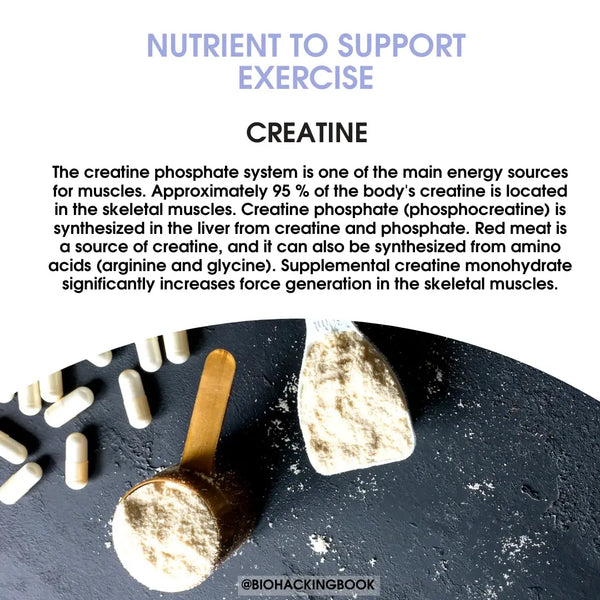
Creatine is naturally occurring in red meat and almost all vertebras. It functions in skeletal muscle energy production by increasing the amount of ATP in the cells. The specific energy system is the creatine-phosphate or phosphagen system. In the cells, creatine phosphate (CP) donates a phosphate to ADP to produce ATP. The creatine phosphate system activates in short and intense bursts of exercise (around 5-8 seconds).
The research behind creatine is MASSIVE. Nearly 100 peer-reviewed human studies show that it increases strength, muscle mass, and power and positively affects on body composition and sports performance.
Quite a few studies have also shown that supplementing with 5 grams of creatine per day increases testosterone (and the following increase in DHT) significantly. When beginning with the supplementation, the elevation of DHT is exceptionally high. One study showed that creatine also helped to diminish potential harmful effects of short-term overtraining while maintaining higher testosterone levels compared to those who didn’t supplement with creatine.
Longer-term creatine usage has not shown any negative/adverse health effects. An overall trend towards higher testosterone serum levels has also been observed in a small study on 26 current or former competitive male athletes (on average, from a baseline of 17 nmol/l to 26 nmol/l) who have used creatine regularly for over a year.
One review done in 2011 on the safety of creatine, concluded the following:
”…high-dose (>3-5 g/day) creatine supplementation should not be used by individuals with pre-existing renal disease or those with a potential risk for renal dysfunction (diabetes, hypertension, reduced glomerular filtration rate). A pre-supplementation investigation of kidney function might be considered for reasons of safety, but in normal healthy subjects appears unnecessary.”
Tribulus terrestris is a plant that has been used for centuries in traditional medicine to treat a variety of ailments, including sexual dysfunction and infertility. One of the key benefits of tribulus is its ability to increase testosterone levels.
Research has shown that tribulus can increase testosterone levels by stimulating the production of luteinizing hormone (LH) in the body. LH is a hormone that signals the testes to produce more testosterone. By increasing LH production, tribulus can indirectly increase testosterone levels.
In addition to increasing LH production, tribulus may also directly stimulate the production of testosterone by the testes. This is because tribulus contains a variety of compounds, including protodioscin and saponins, that have been shown to enhance testosterone production.
Recommended product:
Ecosh Testoboost - Tribulus & Buckthorn
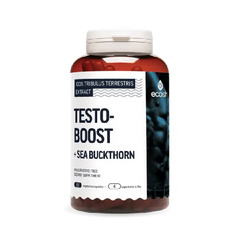
Lesser-Known Biohacks For High Testosterone
We have now covered the basics for optimizing testosterone that you need to know and do first. Next, I will introduce you to methods that have not been discussed (not at least extensively) and go into the category” biohack yourself into a T monster”. These methods are also science-based, but in some of the hacks convincing human studies are still to be seen.
1. Electrical (muscle) stimulation
A study on a rat’s gastrocnemius muscle (calf) found that electrical stimulation induced a rapid increase in the number of androgen receptors in the early parts of the stimulus. This again leads to an increase in muscle mass by enhancing the muscle sensitivity to androgens.
Another study conducted in humans showed that electrical stimulation of volunteers’ meridian points (which means electro-acupuncture) increased subjects’ concentrations of total testosterone and DHEA-S without affecting LH or FSH (secreted from the pituitary gland).
2. Red light therapy (photobiomodulation)
Red light and near infra-red light (NIR) therapy (photobiomodulation) has been used to treat various conditions, from pain and muscle aches to wound healing, skin conditions, osteoarthritis, and even depression (read a comprehensive article on the general benefits of red light therapy and photobiomodulation here).
These effects are usually local, but red and near-infrared light also have systemic effects via blood circulation. You should read this super comprehensive article on red light and NIR therapy by a Finnish dentist Vladimir Heiskanen. He has been a key source of information for me regarding the healing effects of red light back in 2015-2017.
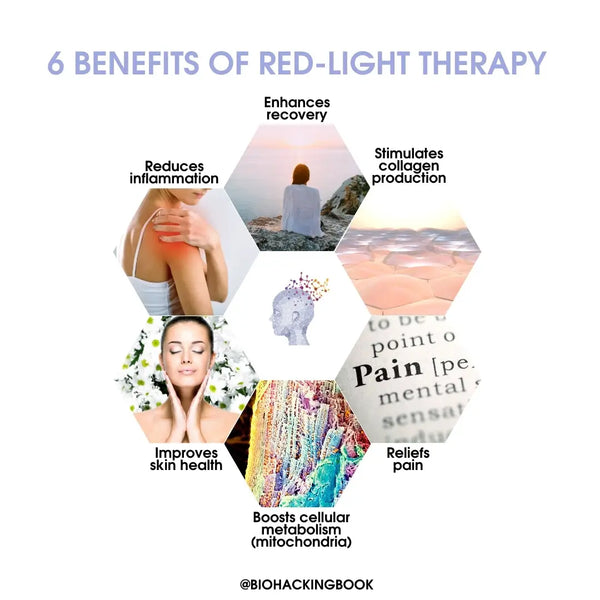
In the past 5-7 years, there has been a big "buzz" on stimulating testosterone production in the testicles by using red light therapy. Many biohackers and celebrities have adopted this into their daily routine, and even Men's Health Magazine covered this topic in detail with Ben Greenfield, who first made this practice better known. The first article on this topic was posted on the RedLightMan's site in 2015.
The basis for stimulating testosterone production by pointing red light (LED) on the testicles lies in the mechanism of how red (or infrared) wavelengths work inside the cell. The key is that they stimulate ATP production in Leydig cells, thus increasing the energy available for the cells. This means more testosterone production. Also, photobiomodulation increases blood flow in the target tissue, which in this case, means more blood flow in the testes and the penis.
There might also be other mechanisms, which are speculated in the” Red Light Man” site:
”Another potential mechanism involves a separate class of photoreceptive proteins, known as opsin proteins. The human testes are especially abundant with various highly specific photoreceptors, including OPN3, which are ‘activated,’ much like cytochrome, specifically by wavelengths of light. Stimulation of these testicular proteins by red light induces cellular responses that may ultimately lead to increased testosterone production, amongst other things. However, research is still in the preliminary stages regarding these proteins and metabolic pathways. These types of photoreceptive proteins are also found in the eyes and also, interestingly, the brain.”
Disclaimer: I haven’t found any human studies on the subject (which makes this method questionable, but it comes with a possibility of having a real effect).
A few studies on rats show that the positive impact on testosterone production is plausible. For example, a Korean study found that low-level laser therapy (LLLT) with the wavelength of 670nm (which is on the border of visible red light and infra-red light) 30 mins per day showed a significant increase in serum testosterone by the fourth day of the treatment without any harmful tissue penetration. In that study, a wavelength of 808 nm didn’t have any effect on T production. Another study done with rams didn’t show any positive impact on T production with 808 nm wavelength. The heating effect of infrared light might be harmful.
- Overall, red (or infrared) light from an LED source is generally thought to be a safe therapeutic method
- Avoid heating the testicles since the heat will destroy sperm cells and harm the Leydig cells (do not use infrared wavelengths)
- Avoid blue light and UV light exposure on testicles (blue light inhibits ATP production in mitochondria)
We recommend the Biohacker's Redlight Panel, where you can easily choose only red light wavelength (there is also a switch for near-infrared light).
3. Get cold showers & cold plunges and keep your testicles cool
”In the 1820s, a German farmer named Vincenz Priessnitz started touting a new medical treatment called “hydrotherapy,” which used cold water to cure everything from broken bones to erectile dysfunction. He turned his family’s homestead into a sanitarium, and patients flocked to it, hoping that his cold water cure could help them."
There is no direct evidence that cold therapy would raise testosterone levels. But, indirect evidence exists. One study in 1988 in Finland investigated serum levels of thyroid and adrenal hormones, testosterone, TSH, LH, GH, and prolactin in men after a 2-h stay in a cold room (10 degrees Celsius). There were no significant changes in the serum concentration of adrenaline, T3, T4, testosterone, TSH or LH. The serum level of noradrenaline increased from 4.5 to 6.3 nmol L1 (P < 0.01), and those of cortisol, GH, and prolactin fell by 20, 87, and 48% (all P < 0.01). This means that by lowering cortisol, you would probably have more of the raw material for testosterone production and less stress response.
The indirect research evidence by in vitro (and animal) studies on optimal testicle function gives us information that testicles should be kept cool (under 35 Celsius or 95 Fahrenheit) also for optimal testosterone production. Heat exposure to testicles has been shown to reduce testosterone levels in rats. Also, an observational study on over 6000 men showed that sperm quality and volume were greater in the wintertime. This is due to stimulation by FSH and LH secreted from the pituitary gland, which also stimulates testosterone synthesis and secretion.
There are also anecdotes from old-school Chinese and Russian powerlifters who iced their balls after training and before a competition. Their goal was to increase performance and testosterone function.
Do these things to improve testicle function:
- Take cold baths and showers
- Wear loose boxers or go” commando” to keep the optimal temperature for testicles and to avoid compression
- Sleep naked or wear just loose pyjamas (no undies)
- Sleep in a relatively cold room temperature
- Don’t sit unless it is absolutely necessary
N.b. Cold-water immersion (CWI) does promote recovery by reducing exercise-induced muscle damage, soreness, and inflammation. However, you don’t want to take cold showers, cold plunges, or ice baths immediately after a resistance training session unless you want to ruin your results – cold water immersion blunts the testosterone and cytokine response after resistance exercise.
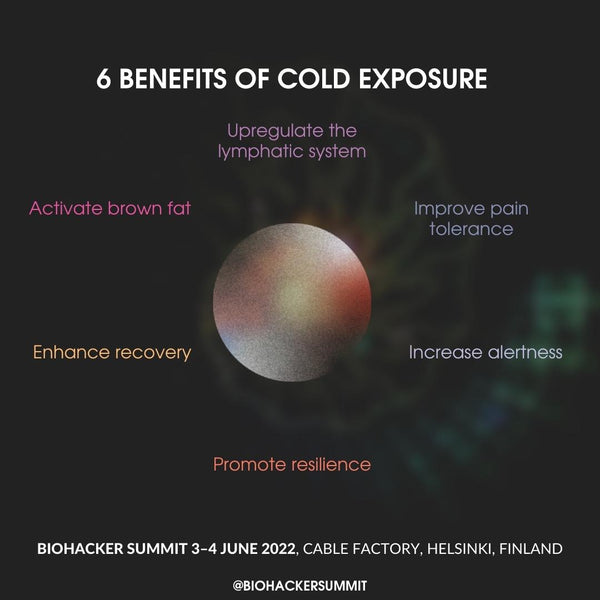
4. Boron
Boron is found in small amounts in the earth’s soil. It functions as a fortifier in cell walls, the bone, the reproductive system, and the brain. A Boron deficiency (daily intake of less than 0.23 mg per day) alters brainwave activity, like magnesium deficiency, by decreasing frontal lobe activity. A deficiency state has been associated with cognitive impairment.
The best food sources for boron are raisins, dried grapes and peaches, almonds, avocados, and dried plums. Boron is well absorbed from the intestines.
One human study showed that boron supplementation (10 mg per day) increased free testosterone (via a reduction in SHBG) and DHT levels and decreased estrogen levels. Boron supplementation also seems to lower pro-inflammatory cytokines.(90) One study done on bodybuilders found that supplementing with 2.5 mg of boron did not have any effect on testosterone levels.(91)
A study done on rats showed that boron accumulates in the testes, and thus long-term use will probably produce the best benefits of using boron. The same study also showed that toxic boron doses could cause testicular lesions. For humans, the safe dosage is up to 20 mg per day (the tolerable upper limit).(92)
My recommendation for a high-quality Boron supplement.
5. Iodine
Iodine is an essential trace element for all living organisms. A healthy adult body contains 15 to 20 milligrams of iodine. The thyroid gland contains the most iodine (70−80 %). Iodine is also present in the mammary glands, testicles, eyes, gastric mucosa, cervix, ovaries and salivary glands.
Iodine plays a critical role in the synthesis of thyroid hormones. Moreover, it promotes normal growth, nervous system development and metabolisms such as protein synthesis and enzymatic activity. Of the thyroid hormones, T4 (thyroxine) accounts for 65 % of iodine by weight and 59 % of T3 (triiodothyronine) by weight, respectively.
Iodine is most abundant in seaweed and seaweed-based products such as nori. Daily intake of iodine should be at least 75–150 micrograms per day. For adults, a tolerable upper intake level is 1100 micrograms.
Lack of iodine in the body (especially in the thyroid gland) can cause various health problems. The most common is hypothyroidism. Men with primary hypothyroidism have subnormal responses to luteinizing hormone (and GnRH), and their free testosterone concentrations are also reduced.
It has been noticed in rats that by increasing iodine supplementation, the mean weight of the testes also increased quite a bit. However, the epididymal sperm counts went down a bit.
One possible explanation for the higher occurrence of hypothyroidism and hypogonadism in men today is an increase in environmental toxic halogens like fluorine, chlorine and bromine. When concentrated enough in the body, they will replace iodine’s locations inside the cells (especially in thyroid cells and Leydig’s cells).
- My recommendation for a high-quality iodine supplement: Life Extension Sea-Iodine.
- Test your iodine levels accurately with Nordic Laboratories Iodine Profile (home test kit).
6. Pulsed electromagnetic fields (dos and don'ts)
The electromagnetic fields emitted from various sources (e.g., mobile phones, microwave ovens, Wi-Fi, etc.) have been reported to have causative effects on biological systems, such as inflammation, radiation and hyperthermia. All of these can disrupt the seminiferous tubules and reduce the Leydig cell population and testosterone concentration (studies done in rats).
Pulsed electromagnetic field therapy (PEMF therapy) has been used successfully to treat various health conditions ranging from bone healing and pain relief to balancing the neuroendocrine system and sleep quality (including hormone production and melatonin levels).
A study conducted on male Wister rats showed that PEMF therapy helped rats to bounce back from microwave radiation in terms of testosterone production and to combat oxidative stress. Rats’ testosterone levels went a bit higher than before the microwave radiation exposure after they were treated with PEMF for 60 days.
Many men keep their mobile phones in their front pockets close to their testicles. It is a fact that mobile phones emit microwaves that are harmful to normal tissues when kept very close to the skin. Several studies have shown relationships between mobile telephone use and reduced sperm count and sperm quality. The adverse effects are highly likely to extend also on lowering testosterone levels in men.
My hypothesis is this: if you know that you are being exposed to external microwaves, Wi-Fi and cell phones, a PEMF device (locally on the testis) or a more general device as full body treatment is likely to revive testosterone levels.
7. Testosterone-boosting herbs: do they work?
Many supplements claiming “testosterone-boosting” properties, including formulations using herbs, spices, plants, or their extracts, do not appear to be supported by scientific evidence. A 2021 systematic review article took a deep dive into this subject. It summarizes, and critically evaluates randomized controlled trials conducted to assess the efficacy of single herbal ingredients on testosterone concentrations, in addition to their fractions or binding proteins, in men.
The review found that certain herbs, particularly fenugreek seed and ashwagandha extracts, can boost testosterone levels in men.
Out of 32 studies, 9 showed a significant increase. Fenugreek seed extracts were the most effective, with positive results in 4 out of 6 studies, and ashwagandha root and root/leaf extracts showed positive results in 3 out of 4 studies. One study showed that forskohlii root extract increased testosterone, but only one study for Asian ginseng with no details on the extract used. Six studies showed no effect. However, due to the limited number of high-quality studies and the different groups of men tested, no firm conclusions can be made about the impact of herbs on testosterone levels in men.
Consequently, due to the shortage of well-conducted randomized controlled trials examining the impact of herbs on testosterone levels in men and the diverse groups of participants involved in these trials, it’s impossible to reach definitive conclusions. Still, it doesn’t mean that any of these herbs mentioned here won’t work.
My conclusion is that ashwagandha and fenugreek are definitely the most promising ones in improving natural testosterone production in men.
Conclusion
The idea of boosting testosterone levels naturally has garnered much interest in recent years. While some herbs, such as fenugreek seed and ashwagandha extracts, have shown promise in increasing testosterone concentrations, the lack of high-quality studies and the varied groups of participants involved in these trials make it difficult to reach definitive conclusions.
It is important to remember that many lifestyle factors, such as diet, exercise, stress, and overall health, influence testosterone levels. Ultimately, a well-rounded, healthy lifestyle that includes a balanced diet, regular physical activity, and stress management strategies can positively impact overall health and well-being, which may impact testosterone levels.
That being said, all the biohacks and cutting-edge ways that you could use to improve your natural testosterone production are, in my opinion, worth testing out. I would also highly recommend that you measure your baseline testosterone levels before implementing any of these methods and then a follow-up test after six months.





